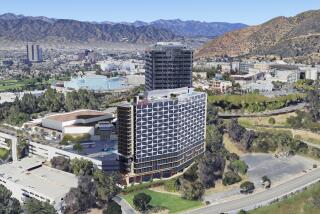IRVINE : Building Boost OKd for Business Complex
The City Council approved plans this week that will allow construction in the Irvine Business Complex to increase by about 15% more than originally planned. The increased construction will require major road improvements in three cities to handle the increase in traffic.
Most traffic improvements will involve roads in the Irvine Business Complex, including added lanes to MacArthur Boulevard, Jamboree Road, Main Street and Red Hill Avenue. But since the 2,800-acre size of the business complex rivals the size of downtown Los Angeles, its traffic impact is expected to spill into neighboring cities.
The business complex spreads from Campus Drive at the Irvine-Newport Beach border north to Barranca Parkway at the Tustin border. The area includes many of the city’s largest office buildings.
The council’s unanimous approval Tuesday to allow increased development included an agreement with the neighboring city of Tustin to widen Red Hill to eight lanes from Irvine’s border at Barranca through Tustin to the Santa Ana Freeway. The council considered a similar agreement with Santa Ana to improve streets there but put off final action until its Nov. 24 meeting.
The proposed Santa Ana agreement calls for widening Dyer Road (called Barranca when it reaches Irvine) from Red Hill to the Costa Mesa Freeway and contributing half the money needed by the two cities to build an Alton Parkway overpass at the Costa Mesa Freeway.
Most road projects would not begin until the level of new construction in the business complex warranted the new lanes.
Irvine began looking into allowing further development within the business complex after realizing in 1989 that officials had approved more construction than allowed under city building limits. Planners spent the next few years looking for ways of handling the increased development as well as being fair to landowners whose properties were not yet developed or were only sparsely developed.
Since the biggest problem expected in the area is heavy traffic, planners formed the solutions around automobiles. Each property was assigned a number of daily vehicle trips it would be allowed to generate. Owners of properties could then build up to that traffic capacity or even sell or trade their allotted trips to another builder.
Traffic engineers also began plans to coordinate traffic-signal timing and add extra turning lanes to keep through traffic flowing during peak hours.
More to Read
Sign up for Essential California
The most important California stories and recommendations in your inbox every morning.
You may occasionally receive promotional content from the Los Angeles Times.









